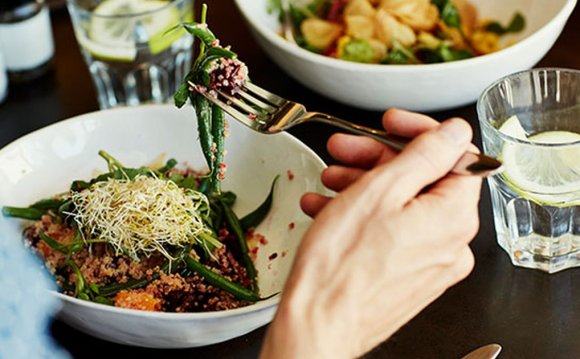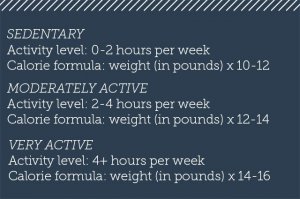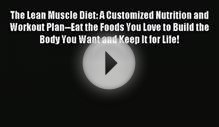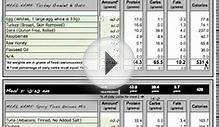
 John Berardi is a nutrition coach and exercise physiologist. He also serves as a performance consultant for Nike and as an adjunct instructor at Eastern Michigan University and the University of Texas. Berardi received his Ph.D. in exercise physiology and nutrient biochemistry at the University of Western Ontario, Canada.
John Berardi is a nutrition coach and exercise physiologist. He also serves as a performance consultant for Nike and as an adjunct instructor at Eastern Michigan University and the University of Texas. Berardi received his Ph.D. in exercise physiology and nutrient biochemistry at the University of Western Ontario, Canada.
Overview
If you’ve ever tried to lose weight and failed, odds are you probably don't have a great relationship with your body. It’s not that you don’t want to make things better - it's just that no matter what you do, you and your body struggle to get on the same page. You want to lose weight and your body, well, it seems to have other ideas.
So we want to offer our own version of counseling. It’s the approach we’ve used at Precision Nutrition with our Lean Eating program. Thousands of clients have used it to lose tens of thousands of pounds. And now we want to share it with you.
While it might look similar to other diets on the surface, this isn’t your traditional eating plan. It’s a smarter, simpler way to lose weight and flatten your belly. The difference is we take a behavioral approach to helping you drop pounds, which puts you in control of what you eat, when you eat, and the confidence you’ll have to finally make changes. We can’t promise that you won’t ever have a disagreement your body, but follow our steps and there will be a lot more love and happiness in that relationship.
It’s not how often you eat, but rather what you eat that makes the biggest difference.
This example eating plan has been specifically created with your goals in mind. During a get-lean plan—where you want to uncover the body you’ve always wanted—the goal is shifting the way you eat to drop fat without having to feel like you’ve cut calories.
So while you will be eating less, you’ll be focusing on more nutrient dense foods that will have you feeling fuller and making the process easier than you’d imagine. More importantly, you’ll be supplying your body with the type of food you need to burn fat and reshape your body.
To this end, we’ve created a four-meal-a-day plan that can apply to any type of daily schedule. We selected four meals because it’s a realistic option for most people that live busy lives. Oftentimes, eating too frequently becomes a hassle and is too difficult to schedule, while eating fewer meals might lead to binge-type eating that undercuts your goals.
However, you can follow this plan as outlined or you can make small adjustments that allow you to eat the number of meals that works best for you. From a scientific perspective, it’s not how often you eat, but rather what you eat that makes the biggest difference.
Photo Credit John Berardi/Precision NutritionThe meal plan below outlines a day of perfect eating for someone trying to get a little leaner. We’ve laid out calorie goals and meal breakdowns for those of you who like to do calorie math. And if you want to really individualize and adjust based on body type and activity levels, this is our approach.
 But the truth is, we’re not big fans of counting calories. Rather, we think you should eat according to hunger cues and adjust according to results.
But the truth is, we’re not big fans of counting calories. Rather, we think you should eat according to hunger cues and adjust according to results.
That’s the real magic of what we do at Precision Nutrition. Instead of strict meal plans we teach a habit strategy, outlining best practices like: slowing down your meals, eating lean protein with every meal, eating veggies and fruits with each meal, and including healthy fats.
Of course, the menu below is an example of these practices in action. Just remember that it’s a template and that you’re in control. In other words, you can adjust as needed. If you don’t like chicken, substitute with steak, fish, or turkey and the same with the veggies, starches and fruits.
Also keep in mind that instead of using ounces, grams and other metrics, we prefer to use the simplest metric possible: the size of your hand. For example, for women we recommend one palm-sized portion of chicken.
This is the preferred approach because your hand generally scales with your body size. If you’re bigger, you eat more, according to your hand size. And if you’re smaller, you eat less, according to your hand size. For more on this strategy, check out our “Simple Guide to Portion Size, ” which we’ve linked to at the bottom of this article.
~3 eggs (1 palm-sized portion)
~1 cup (1 fist-sized portion) of spinach
~1 slice (1 cupped handful) sprouted-grain toast
~1 tbsp (1 entire thumb) almond butter
~¼ cup (1 cupped handful) mixed berries
~1 glass water / green tea / black coffee
~4 oz (1 palm-sized portion) of light tuna
~1 cup (1 fist-sized portion) chopped cucumbers and peppers
~1 tbsp (1 entire thumb) of guacamole
~1 sprouted-grain wrap (1 cupped handful)
~1 cup (1 fist-sized portion) baby carrots
~1 glass water/green tea black coffee
~1 scoop (1 palm-sized portion) protein powder
~1 cup (1 fist-sized portion) spinach
~1/4 cup (1 cupped handful) strawberries
~1 tbsp (1 entire thumb) extra virgin coconut oil
~8 ounces unsweetened vanilla almond milk
~Ice cubes as desired
~4 oz (1 palm-sized portion) of chicken
~1 cup (1 fist-sized portion) of asparagus
~1 tbsp (1 entire thumb) of extra-virgin olive oil
~1/2 cup (1 cupped handful) quinoa
~1 glass water
Calories: 1, 554
Protein: 130g
Carbs: 110g
Fiber: 28g
Fat: 66g
The most common question we receive is: “How do I know if it’s working?” Well, your strategy should be based on what your body weight is doing, and what you’re seeing in the mirror. On this plan, you can expect to lose about 2 to 3 pounds per month.
However, keep an eye on things to determine if you need adjustments. If you’re losing weight too quickly, simply eat a bit more by increasing your calories/portion sizes. And if you’re gaining weight (or not losing at all), simply eat a bit less by decreasing your calories/portion sizes.
Over time, you will have to adjust. Based on preferences, based on variety, and based on your results. That’s the beauty with a flexible approach to nutrition: There are unlimited variations.
INTERESTING VIDEO












